In this post, I visit a walled Konso tribe settlement and find myself at a Hamar bull jumping ceremony, in which a boy becomes a man through a series of amazing rites that a visitor might find unfamiliar and shocking.
A little background: I visited South Omo (also known as Omo Valley) in December of 2015 as part of a one-month trip throughout Ethiopia. South Omo is best known for its amazing density and diversity of living African tribes. This is the second post of a travelogue series on southwest Ethiopia, covering around seven days of activity in its entirety.
Before you read this, make sure to check out my how-to guide on preparing for a South Omo trip for an introduction to the region, as well as South Omo, Ethiopia: Part 1, Arba Minch, the first post in this series.
South Omo, Part 2: Hamar Bull Jumping Ceremony & Konso Village Visit
This post will cover one day’s time (December 13th, 2015), including the following events:
- Departing Arba Minch with guide and driver
- Konso settlement visit
- Visiting the village of Dimeka for a Hamar Bull Jumping ceremony
- Ending the day and sleeping in the village of Turmi
My guide, driver and I left Arba Minch in our minibus at 8:00 AM, heading south toward our first destination, the small town of Konso, which lies a short ways due south of Arba Minch. The roads were reasonably good for most of the way but were often covered in large herds of cattle and goats.
After about 2.5 hours on the road, we arrived in Konso.
Konso Tribe Village Visit
The Konso culture is listed as a UNESCO world heritage site due to the design and implementation of Konso tribe settlements, which sets them apart from other tribes in southern Ethiopia. Perched atop arid hills, these permanent settlements incorporate fortified stone walls (often one meter thick and two meters high or more) with an inventive system of farming that helps to manage water usage and minimize erosion on the slopes below the village.
Inside the Konso villages, family compounds are set apart by additional internal walls and long walkways. The results are densely populated villages that maintain feelings of both security and community.
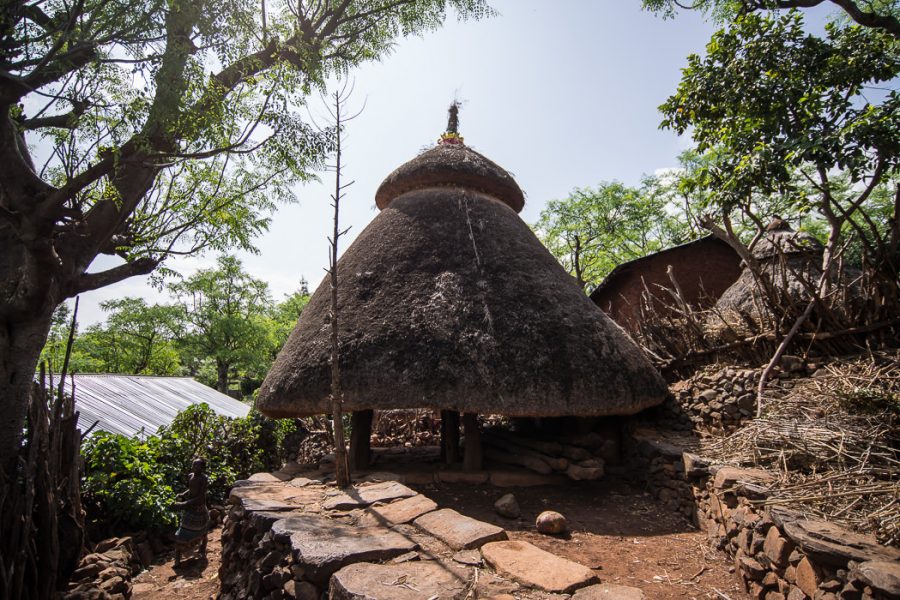
A traditional Konso dwelling.
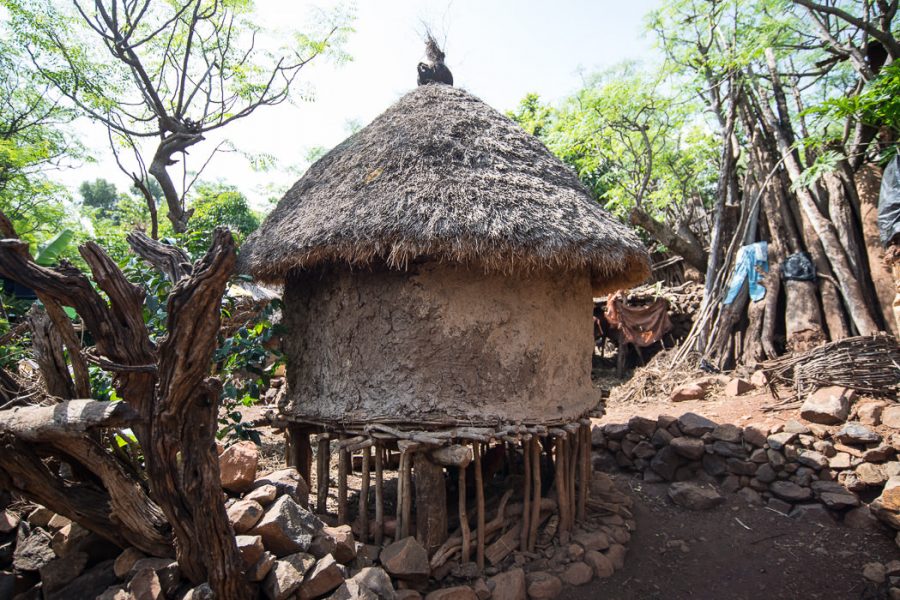
A storage hut on stilts.
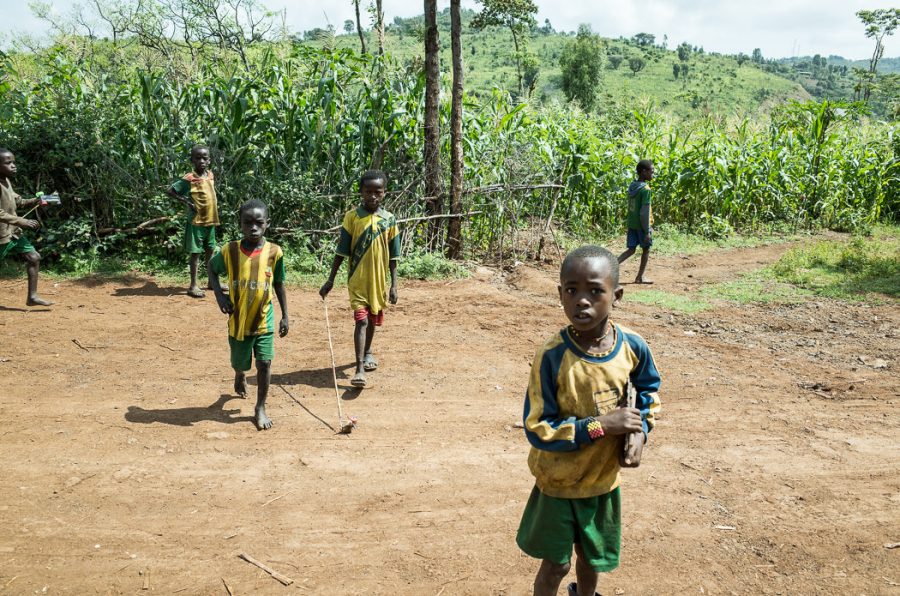
Konso kids.

A homemade toy.
The Konso people are not as often photographed as some of the other tribes of southern Ethiopia, as their traditional clothing and style is not as fetishized as some of the other tribes like the Mursi, Surma and Hamar, whose looks may appear more exotic to photographers. The first thing most visitors will notice about day-to-day Konso style is the two-tiered, often colorful skirt that many Konso women wear.
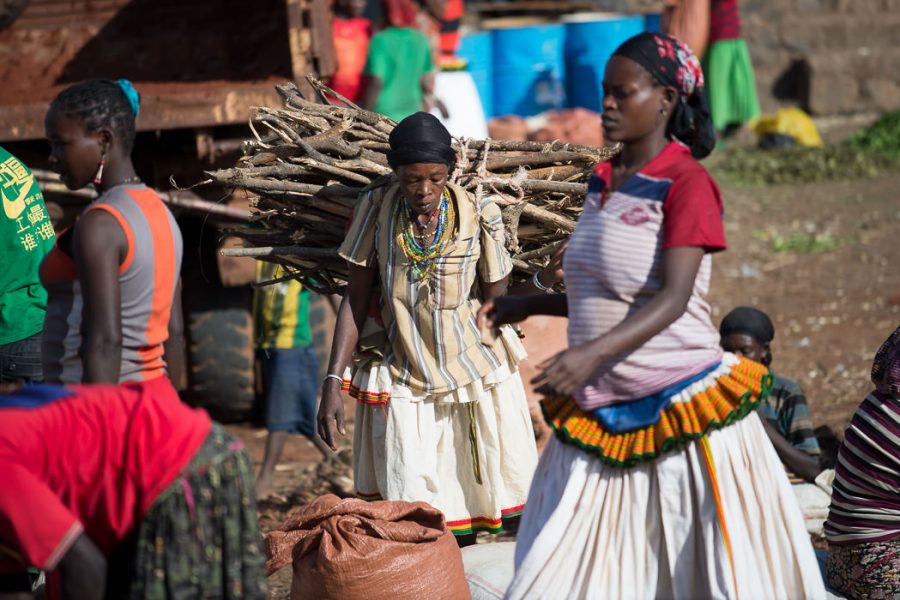
Examples of Konso women’s ruffled skirts.
After about an hour walking through the Konso village, we continued west on the Konso-Jinka highway.
En Route from Konso to Dimeka
On the side of the road every few miles, we saw groups of young boys that would dance like crazy (totally insane kid moves) in hopes that you would photograph them and pay them. Also, in certain spots along the way, we saw boys and young men with painted faces, standing atop stilts, waiting for the same kind of photo-for-pay deal.
This was my first taste of the fee-for-service photography business that South Omo can feel like at times. The message was clear: if anyone seems to want you to take their photo, they want you to pay them as well. This would end up being one of the overarching themes of my visit to South Omo.
I didn’t stop to photograph any of these dancing / stilted boys because our schedule was quite full as it was, and these also weren’t really photo opportunities that spoke to me – although seriously, some of these kids have some crazy futuristic original dance moves! We kept rolling along.
Another strange thing I witnessed along the way: as we crossed part of the floor of the African Rift Valley on this day (most of tribal South Omo is located within part of the Rift Valley), we whizzed by some men on the side of the road who were holding up a dead dog by its leg. What? My guide told me that the locals were doing this because they perceived that Chinese tourists might be interested in buying the dead animal for use as food. I mean, if Anthony Bourdain did it, it’s ok, right? Moving on…
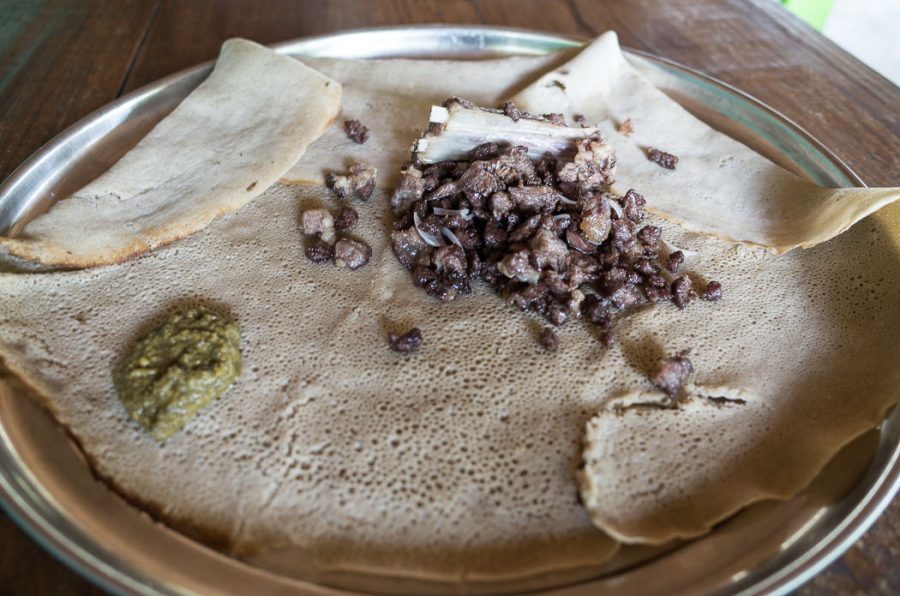
I had goat tibs on injera for lunch.
The road between Konso and Jinka is quite good and well paved, but turning south at Key Afer, toward Dimeka, made for considerably rougher conditions. Much of the road turning to rutted dirt rather than paved tarmac, and our ride became a much slower, much bouncier affair.
We arrived in Dimeka at around 3:30 PM. A local guide named Frank excitedly approached our minibus and told us that a Hamar bull jumping ceremony (coming of age ceremony) would be taking place very soon nearby, and that we should hurry if we wanted to witness the proceedings. He jumped in our minibus and we proceeded to drive on what looked more like brush-covered walking paths than roads, toward a Hamar tribe village.
There had been no prior guarantee that a Hamar bull jumping ceremony would occur on this day, as there’s no official calendar that one can reference for such events – so we were very lucky to run into Frank this afternoon.
Hamar Bull Jumping Ceremony
I had heard about Hamar bull jumping ceremonies prior to my visit to South Omo – but reading about these ceremonies didn’t fully prepare me for the experience of being there.
The second we disembarked from the minibus, we sprang into action with minimal introduction. Frank, fire in his eyes, ran me back and forth across the village to wherever action was taking place.
First, we met the young initiate, who was to become a man on this day, if he could successfully run four times across the backs of multiple bulls, without falling.
Our next stop was the interior of a Hamar hut – Frank quickly ushered me in for a lightning quick visit. And just as quickly, it was time to move on. I thanked the man in the hut and followed Frank back outside.
Frank hurried me across a field toward where the first portion of the bull jumping ceremony was starting to transpire, informing me of what was next while we were more or less running:
The whippers are coming! The whippers are coming!
The “whippers”, unmarried Hamar men carrying long, thin, flexible branches and often wearing feathered headdresses, were entering the village. The adult female family members of the young initiate immediately gave chase to these men, encouraging the whippers to whip their bare flesh, as a show of strength and solidarity with the boy who was to jump the bulls that day.
The whippers ran away from the women, but the women continued to give chase, verbally and physically harassing the whippers and encouraging them to lash them again and again. These lashings resulted in sizable open wounds on the flesh of the women, many of which would become scars, worn proudly as a prior show of strength.
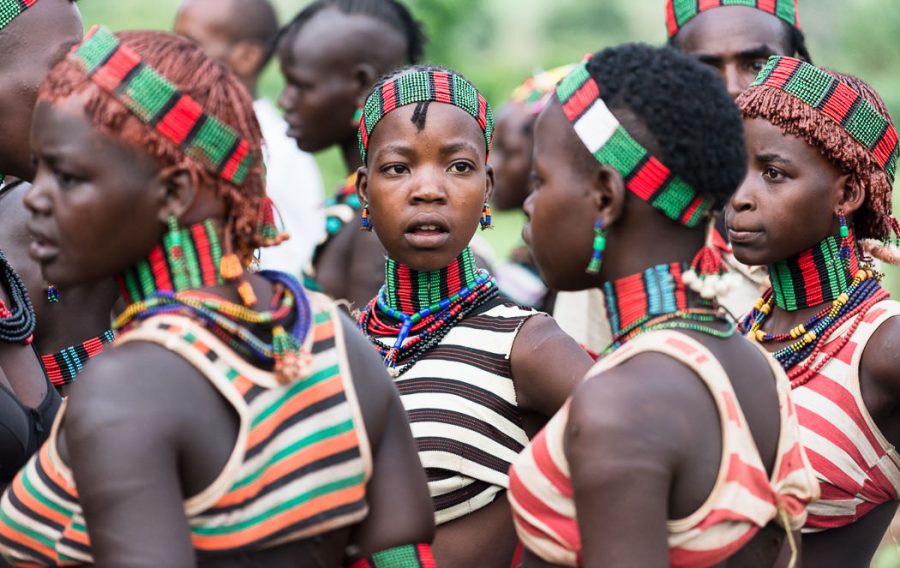
The young women dance and sing during the ceremony, but generally were not whipped in the course of the proceedings.
Throughout most of the ceremony, the women would continue to dance and sing loudly while drinking alcohol out of plastic bottles, periodically pushing the whippers to lash them again.
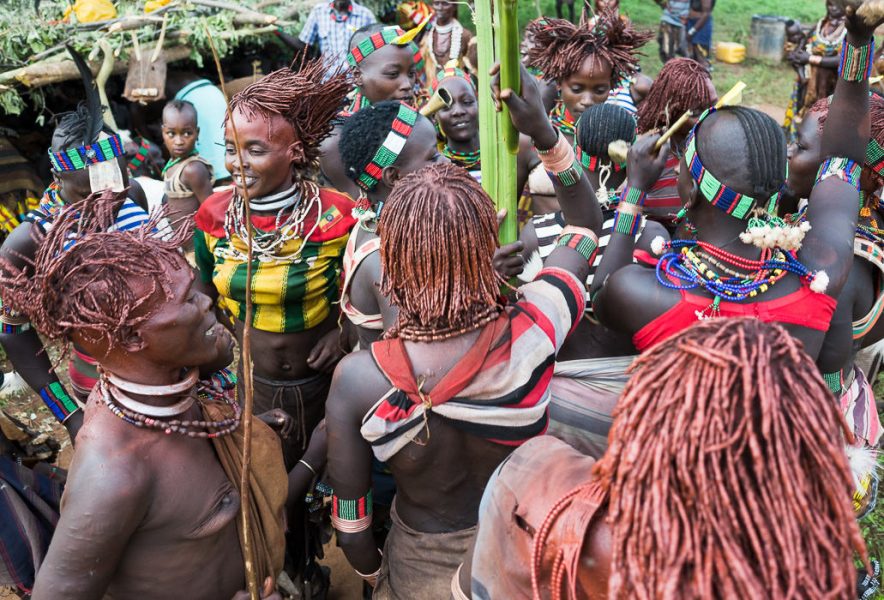
The women dance and sing together.
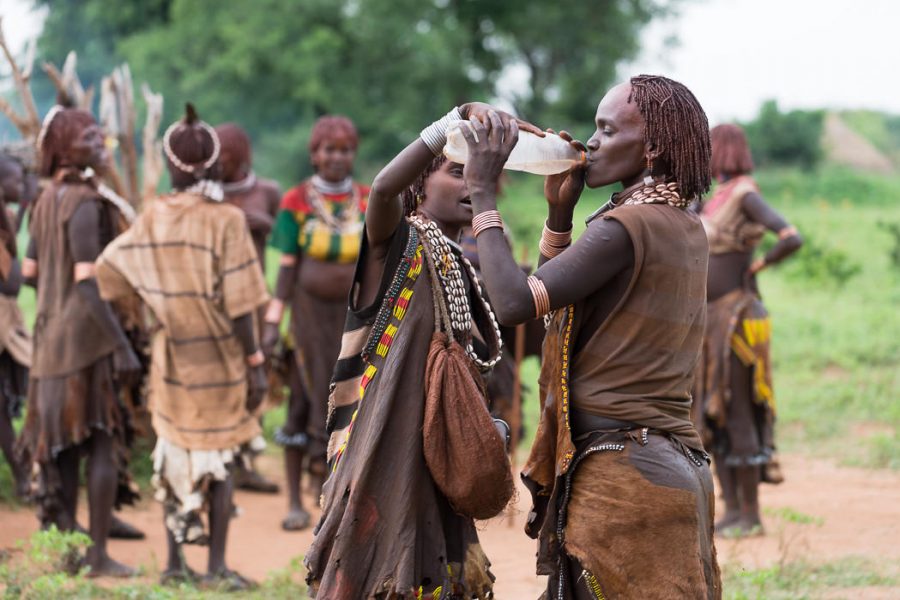
Sharing a drink.
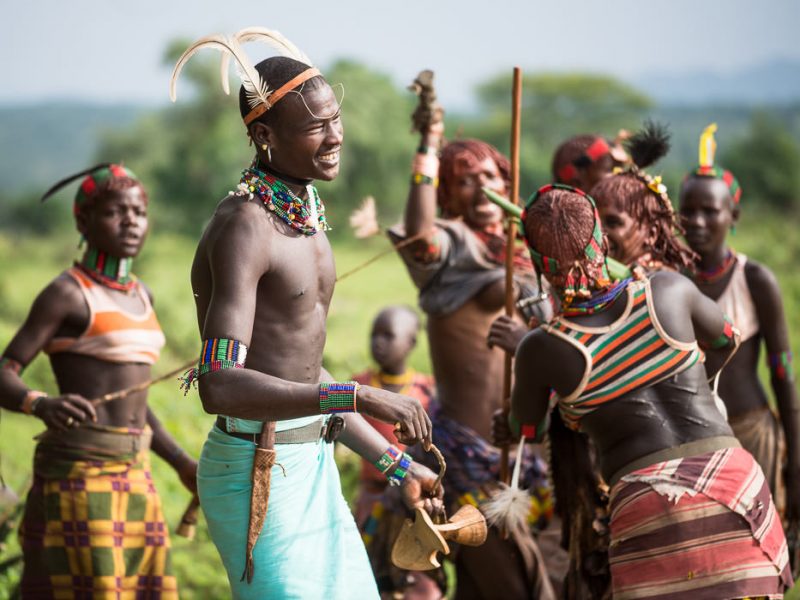
Despite the inherent violent whippings that took place during the ceremony, both the women who were lashed and the whippers seemed to be in good spirits.
After drinking, singing, dancing, whipping and a number of other rites, cattle were selected and arranged into a long line as a living platform for the boy to jump atop and run across. I have read that sometimes the backs of these cattle are smeared with dung to make the run across their backs even more slippery and dangerous for the jumper, but this was not drawn to my attention at the ceremony I witnessed.
The initiate, now fully nude and surrounded by the entire village (as well as a small contingent of tourists from Israel and New York in our case), must now do his part: jump from the earth to the backs of the bulls in order to run down the line four times – twice forward and twice back. Should the initiate fail to cross to the tribe’s satisfaction the consequences can be dire, including humiliation and beatings from the tribe. Additionally, should he fail, the boy will be forced to wait a year in order to jump the bulls again.
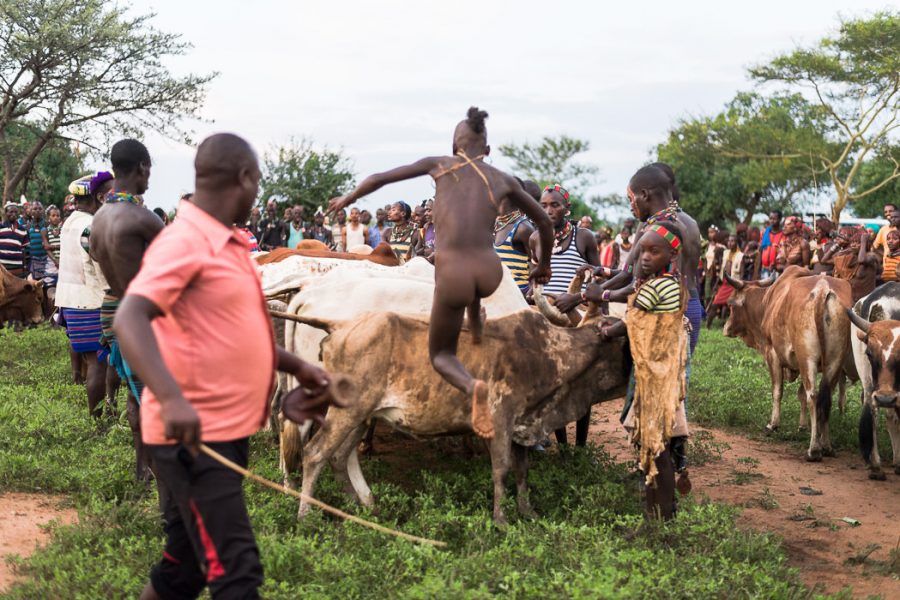
Leaping onto the first bull.

The fourth and final crossing. Frontal nudity blurred out.
Our jumper suffered only a bit of a stumble on his first pass, then completed the next three without error. He had passed the test and thus come of age in the eyes of Hamar culture. After his success, the boy’s family and community gathered around him and adorned him with a goatskin and beads.
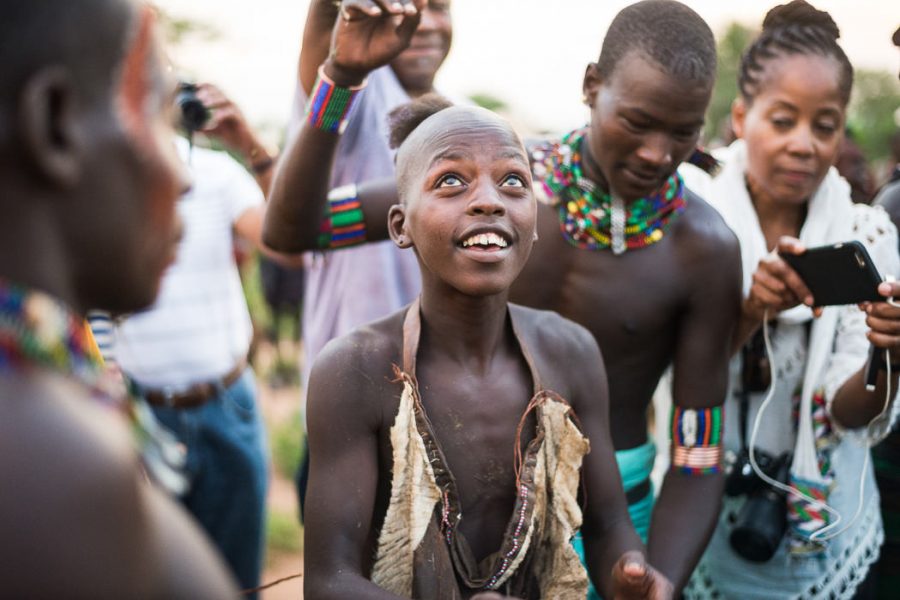
Sweet relief.
For another look at Hamar bull jumping ceremonies, I recommend you check out this highly informational photo essay by photographer Eric Lafforgue.
Photographing a Bull Jumping Ceremony
Though my local guide Frank told me again and again that it was 100% OK to photograph absolutely anyone at a bull jumping ceremony any time I pleased, some tribespeople I photographed were still fairly shocked or irritated about being on camera – which is understandable, as I had read that some Hamar people still believe that photography “drains their blood”.
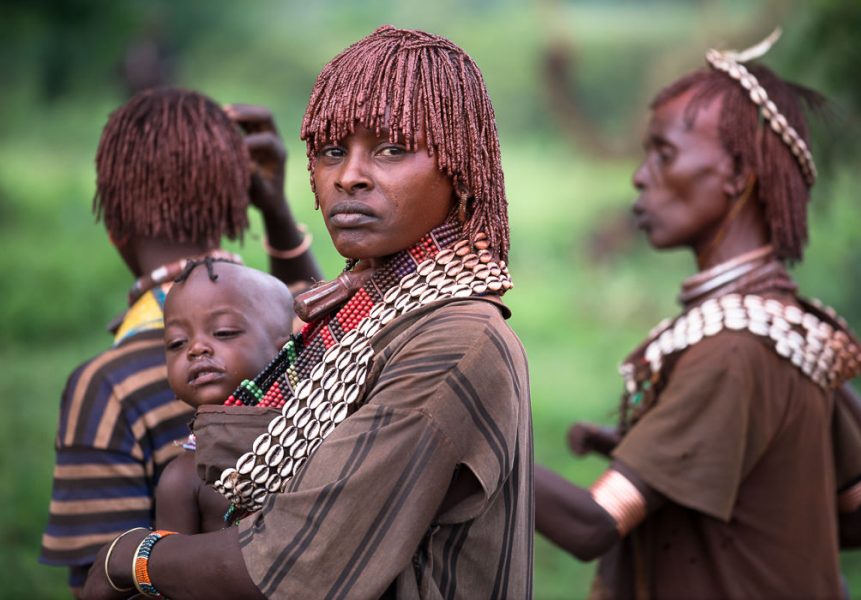
This woman didn’t seem thrilled to be photographed. I thought she looked quite striking with her ochred hair and puka shells.
Then again, others were perfectly comfortable on camera and didn’t seem to perceive my presence negatively.
Bull Jumping Ceremony – Associated Costs
Though I wasn’t required to pay any individual incidental photo fees to any of the Hamar tribespeople at this village, I did pay 700 Birr (around $33.00 US) as a total fee for attending the bull jumping ceremony, which I handed to my primary guide, Ephrem. I can only hope that a fair amount of this money made its way back to the tribespeople. I also tipped Frank an additional 100 Birr (about $5.00 US) for his help.
At this point the sun was beginning to set, so we drove back through the brush and into Dimeka in order to continue south toward Turmi, where we would spend the night. The road itself wasn’t much better than driving through the brush, so we bumped and jumped our way down the poorly maintained road until arrival.
Arrival in Turmi
That night, we stayed in Turmi’s Green Hotel, a small place with around 10-15 very basic rooms. My room had cinder block walls, chicken wire for a window, an exposed bulb for lighting, and a bed with a mosquito net. The shared bathroom at Green Hotel was like a smaller, darker, wetter, considerably dirtier version of the bedroom, but with no bed and many, many more mosquitos.
After a quick dinner of spaghetti with meat sauce at the next door Tourist Hotel (unaffiliated with the Arba Minch Tourist Hotel to my knowledge) I took a cold shower and headed off to bed – there wasn’t much else to do in tiny Turmi. Our driver, Masai, slept on a bench seat in the minibus.
Spaghetti in southwest Ethiopia?
Yep. You’ll find simple Italian food (primarily different types of pasta) nearly everywhere in Ethiopia – it’s the second most common type of food one encounters in Ethiopia, aside from Ethiopian food. The reason for this: Italy occupied Ethiopia from around 1936 to 1941, and some of their food stuck around after the imperial effort, as it so often does (French food in Vietnam, anyone?).
But the Italians didn’t stick around long: Ethiopia’s Emperor Haile Selassie defeated the Italians in battle in 1941 and forced the occupiers out. Italy formally recogned Ethiopian sovereignty in 1947 after the end of World War II. Ethiopia and Liberia are the only two African countries never truly “colonized” by European powers.
Next up in South Omo, Part #3:
The next day we would visit a (rather aggressive) Dassenech tribe village in Omorate, the somewhat friendlier Karo tribe in the village of Kolcho, and return to Turmi just in time to catch the tail end of a Hamar tribe market day. Oh, and we get our minibus stuck in a small river, and our driver Masai gets an AK-47 pointed at his head, so there’s that too. Stay tuned for part #3 of my trip through South Omo.
Thanks for reading!

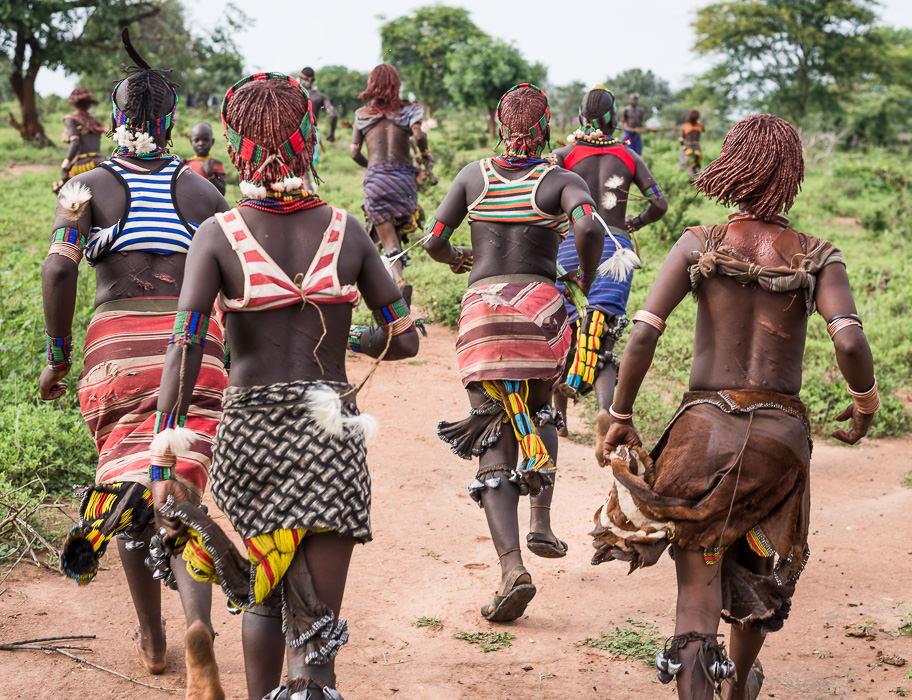

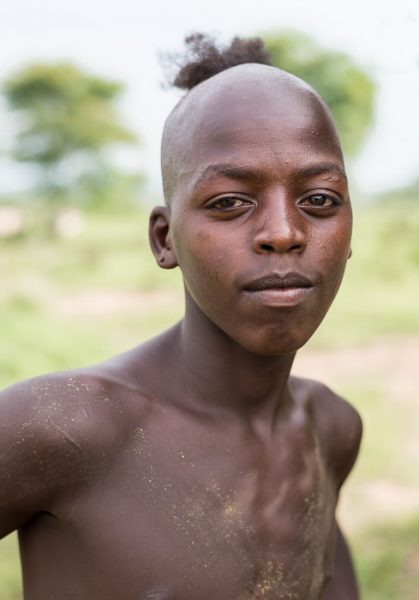
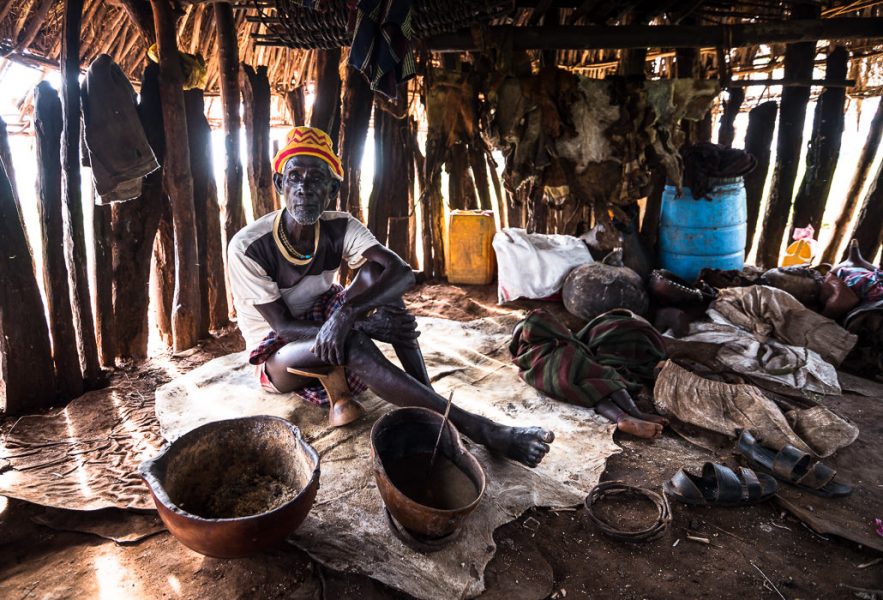
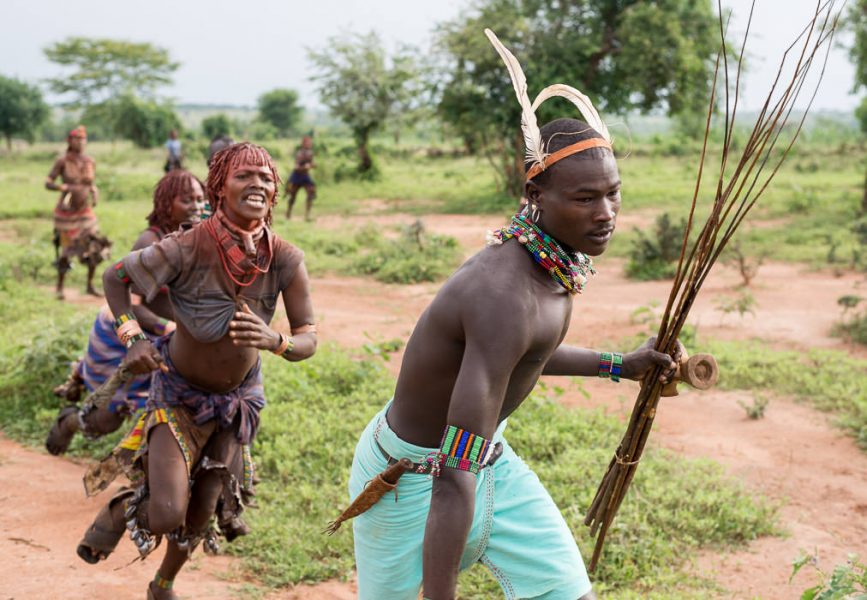

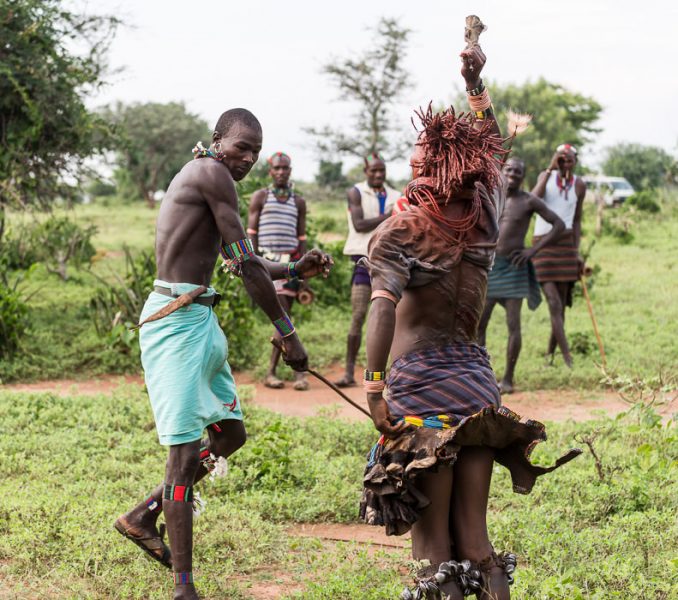
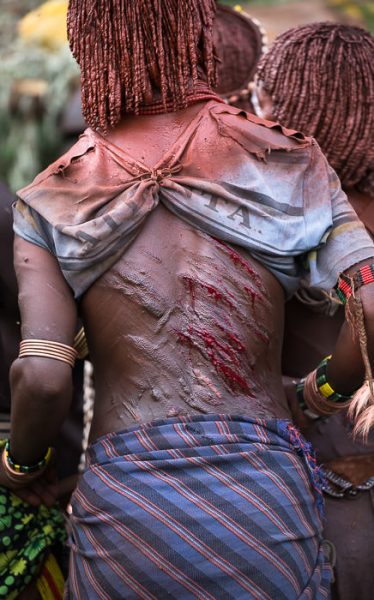
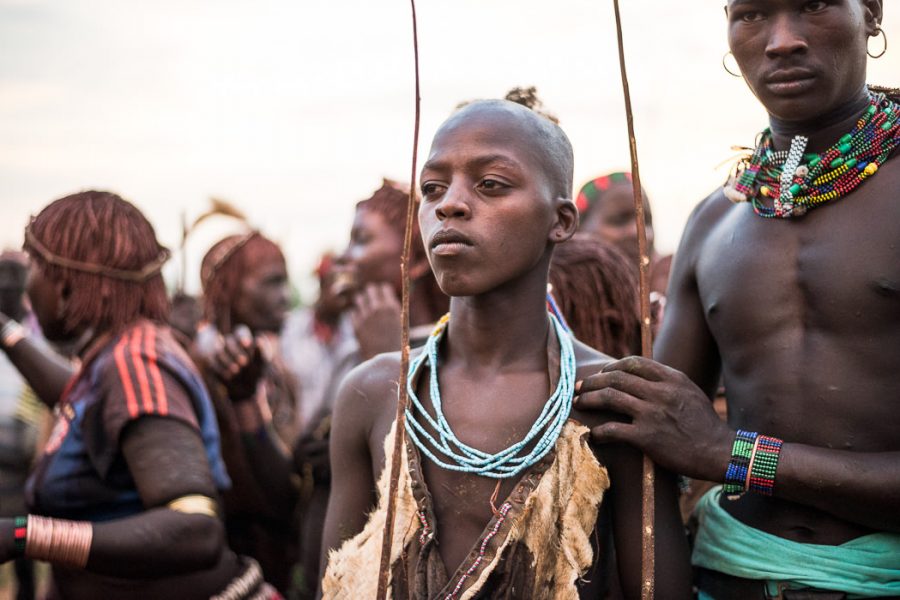
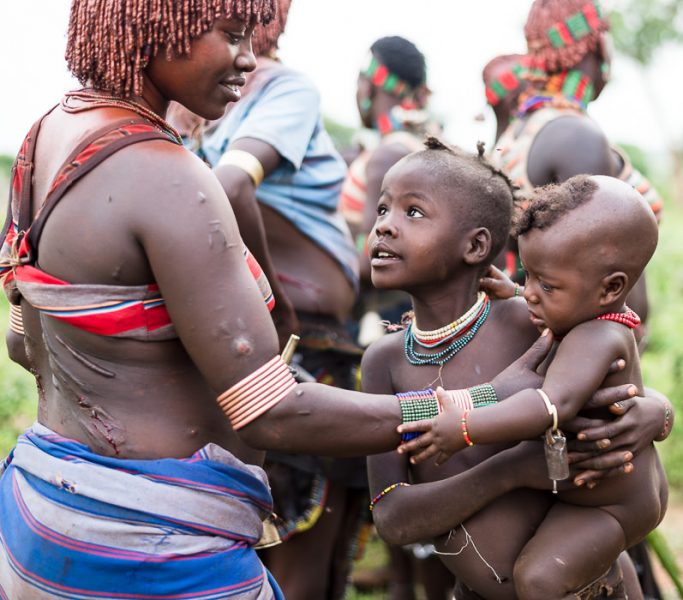
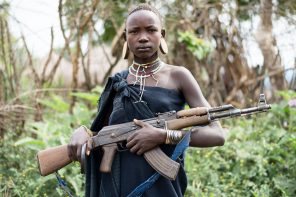
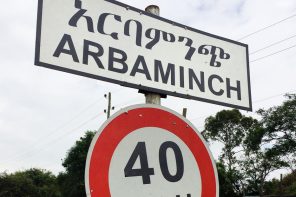
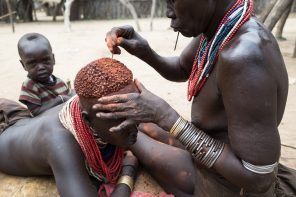
Wow, what an adventure! Great photos and wonderful detail.